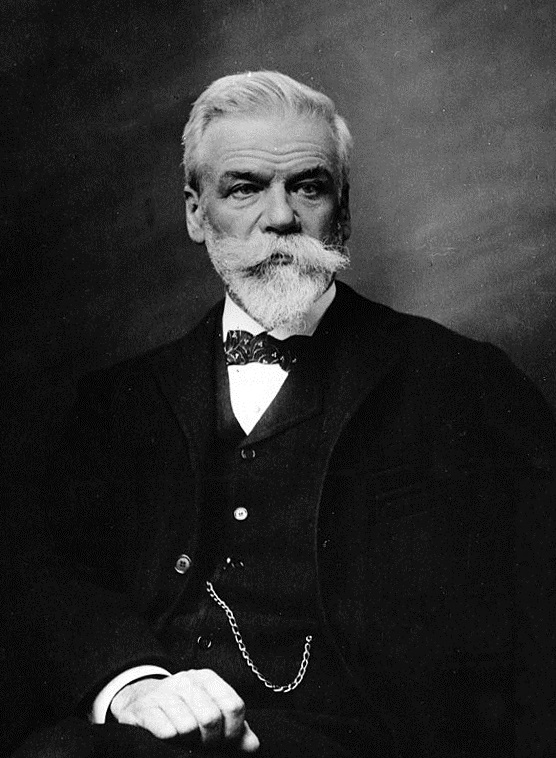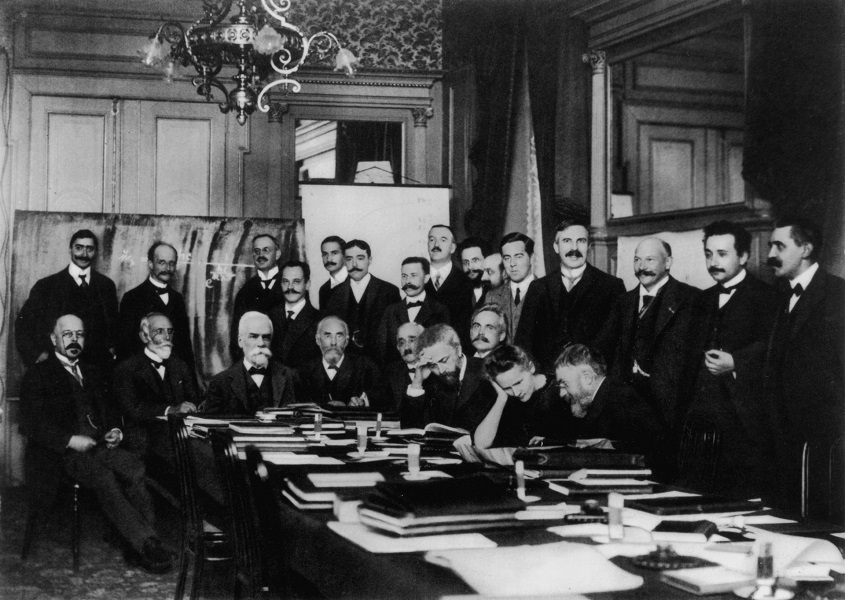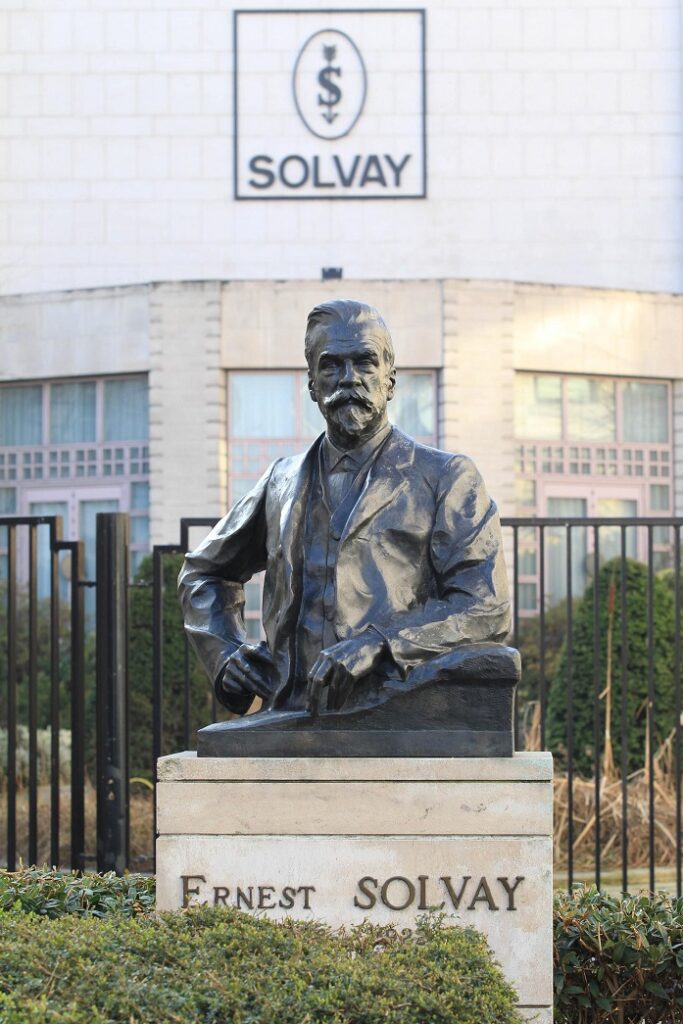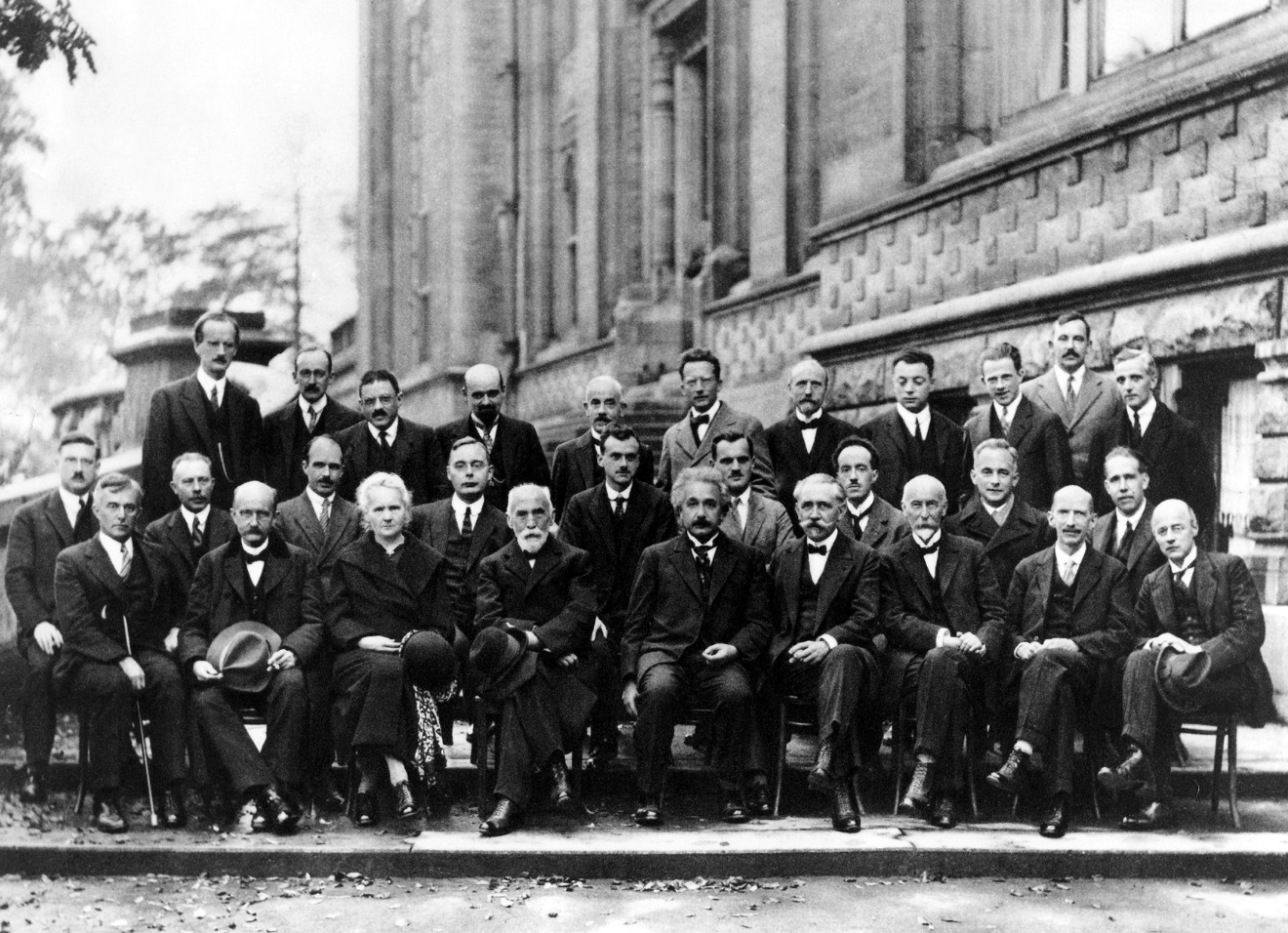The Solvay name is found across Brussels and beyond, attached to schools, a large corporation, a library and a park. But who was the man behind the legacy?
The stone mount on which sits the impressive bust of Ernest Solvay, on Chaussée d’Ixelles is merely inscribed with his dates: 1838–1922. It is planted in front of the Brussels offices of the Solvay company that he founded in 1863 with his brother Alfred, a chemical production business that would in his lifetime become one of the largest multinationals in the world. The statue’s plain messaging belies an extraordinary life of an entrepreneur, technology pioneer, industrial titan, philanthropist and amateur scientist whose work even ties in with quantum theory.
Ernest Solvay was laid to rest 100 years ago in the nearby Ixelles cemetery after a prodigious career, much of which is not widely known today, even by students at the numerous educational institutes that he founded. Although Solvay was passionate about physics from an early age, he never received any formal education in the subject due to acute childhood pleurisy.
That did not deter him: he told his sister that he was trying to solve the big mysteries of the universe. What set him apart from other dreamers was a will and supreme confidence in his intuition.
Working at his uncle’s chemical company, he wondered how the plant’s waste product, ammonia, could be gainfully re-used. He discovered that by dissolving the ammonia in water and adding salt brine he could make soda ash (sodium carbonate), a product used by Europe’s burgeoning glass, textile and soap industries. While others said the process had already been tried with little success, Ernest was not discouraged. The fact that someone had the idea before meant that it was probably a good one, he said. It just hadn’t been pursued properly.
And succeed he did, owing in part to the diligence to which he would monitor and adjust his production systems. The ammonia-soda process he developed in the 1860s became known as the Solvay process and would go on to replace the Leblanc process, producing soda at a significantly lower cost.
Solvay also understood that the business that he established to exploit the technology needed to be international. Plants would have to be set up outside Belgium with easy access to the required raw materials.
That meant building a business empire. Factories were established around the world, making the Solvay company one of the defining industrial drivers of the 19th century. Their name would spread far and wide: Geddesburgh in New York state would be renamed Solvay when the company built a plant there; the village next to a Solvay plant in Livorno in Italy would be named Rosignano Solvay.
The Solvays became fantastically rich. And politically influential: Ernest Solvay was elected to the Belgian Senate, for the Liberal Party. But after 30 years of producing soda, Ernest would leave his brother in charge of the company to pursue his true passion: science.
Theory of everything
Central to Solvay’s thinking was the belief that energy is related to mass. This relationship would be famously formulated in 1905 with the publication of Albert Einstein’s special theory of relativity.
Solvay’s grand theory, which he called his ‘gravito-materialistic’ theory, was a basic law linking energy and gravity. He thought that Kepler’s planetary motion laws could be applied at the molecular level. Others also made a connection between celestial laws and atomic physics, but they were in a minority. While Niels Bohr later likened electrons in an atom to planets orbiting a sun, his comparison was illustrative.

Portrait of Ernest Solvay
Solvay’s ideas were nevertheless at the heart of the founding of the institutes that bear his name. He believed that the physical laws that govern the universe also govern biology and even sociology. Since Belgium lacked physicists to whom he could ask to test his theories, he turned to his medical doctor, Paul Héger, to help set up an institute focused on physiology.
Completed in 1894 in the Parc Léopold in Brussels, the institute was divided into two parts by the building’s central staircase: one half was devoted to university education, while the other was where his energy-based ideas on physiology would be developed (the Institute of Physiology is now the Lycée Émile Jacqmain).
Three years later, Solvay began to fund the school of political and social sciences at Université Libre de Bruxelles (ULB). And in 1901 he established an institute of sociology near to the physiology institute to underscore his belief in the closeness of the two disciplines. The building was renovated in 1994 and now holds the Bibliothèque Solvay. Separately, the Solvay Business School was founded in 1903, eventually becoming part of the ULB as a school of economics and management.
Meeting of great minds
The physics and chemistry institutes, on the other hand, emerged later and owe their existence to the Solvay conferences. The story of the first symposium in Brussels in 1911, which brought together such venerable names as Marie Curie, Albert Einstein, Max Planck and Ernest Rutherford, begins with one man’s quest for a Nobel Prize.
That man was Walther Nernst, a German chemist whose heat theorem helped pave the way for the third law of thermodynamics. He envisaged the conference as a means of publicising his theorem. Trying to reconcile the theories of Einstein and Max Planck, Nernst saw how their ideas fed one other. That gave him the notion of a conference examining quantum theory and bringing it to a wider audience.
The event changed the course of science. “There was a before and after the 1911 conference,” says Prof Franklin Lambert of the Vrije Universiteit Brussel (VUB). “Modern physics started when leading experts realised that the classical period had come to an end, and that is exactly what happened in the aftermath of the first Solvay conference.”

The first Solvay Conference, 1911
Solvay’s involvement owes much to his connection to Berlin where he was known for his generous donations to scientific research. In fact, Nernst had persuaded the Royal Prussian Academy of Sciences to award Solvay the Leibniz medal in 1909 for his support. Since he could not be seen to be leading his own charge for a Nobel Prize, a goal he would finally achieve in 1920, Nernst turned to Solvay for help. “He needed neutral grounds and no place was more neutral than Brussels. It was the perfect no man’s land,” says Lambert, who is also the co-author with Frits Berends of ‘Einstein's Witches' Sabbath and the Early Solvay Councils. The Untold Story’.
Solvay was also interested in Nernst’s heat theorem and felt a kindred spirit with the chemist over a shared rejection of kinetic theory. In his opening address to the conference, Solvay astonished the select group of just over 20 leading figures by expressing this view.
The venue was a small meeting room at the Hotel Métropole, then considered the most luxurious hotel in Brussels: in letters home, the distinguished invitees marvelled at the possibility of taking a bath in their rooms.
The conference was chaired by Dutch physicist Hendrik Lorentz, who also on Solvay’s behest convened a committee of nine attendees to help him develop experiments on Brownian motion and radioactivity – two subjects close to Solvay’s grand theory. The idea of founding an international institute to oversee this work emerged from this committee. The resulting International Solvay Institute of Physics was followed by the establishment of a chemistry institute several months later under Wilhelm Ostwald’s leadership.
The two institutes merged in 1969 and continue to host international conferences. Solvay died a month after the first chemistry conference in May 1922, aged 84. However, the scientific impact of his various initiatives continues to be immense. Today, a hundred years on from his death, an initiative has been launched to obtain UNESCO recognition of the cultural heritage of the early Solvay conferences.
On his passing, Dutch Nobel Laureate Heike Kamerlingh Onnes paid tribute to “his unwavering faith in the effectiveness of research carried out with method and perseverance…All those who benefitted from his generosity will remember his eyes, in which shone the conscience of having done what was right.”
Town and country
Ernest Solvay bought Chateau de la Hulpe on the edge of the Sonian Forest as his country pile in 1893. Built in the Flemish neo-renaissance style, the house is now a venue for hire, while the surrounding, publicly-owned 227-hectare estate offers pleasant strolls for ramblers. The estate also hosts Fondation Folon, a museum dedicated to the illustrator, painter and sculptor Jean-Michel Folon.
Many wealthy Brussels residents began to acquire summer residences in the area around the second half of the 19th century, attracted by the ease of access afforded by the new rail line. The station at La Hulpe was opened in 1854.
One such illustrious resident was the architect Victor Horta, who Solvay knew well and asked to redesign elements of the property. Sadly, the chateau no longer contains his interior additions, such as an adjustable chandelier, though his recognisably Art Nouveau hand water pump still has pride of place. Horta would later design the Art Nouveau masterpiece Hôtel Solvay on Avenue Louise for Ernest’s son, Armand Solvay.
Ernest Solvay’s legacy at the chateau is a second entrance that avoided a shrine created by the previous owner, Baron Antoine de Roest d'Alkemade. Inspired by the reported appearances of Mary at Lourdes in 1858, the Baron’s grotte wasn’t included in the initial sale and remained open to the public. “Solvay wasn’t a Catholic at all, and it bothered him a little bit,” says Jacques Stasser, president of the Cercle d'histoire de La Hulpe. “Although he said that the new entrance was built to avoid disturbing the locals; in fact, he just didn’t want to see it!” When the site became part of his estate in 1909, the shrine was moved to the centre of the town where it remains today.


